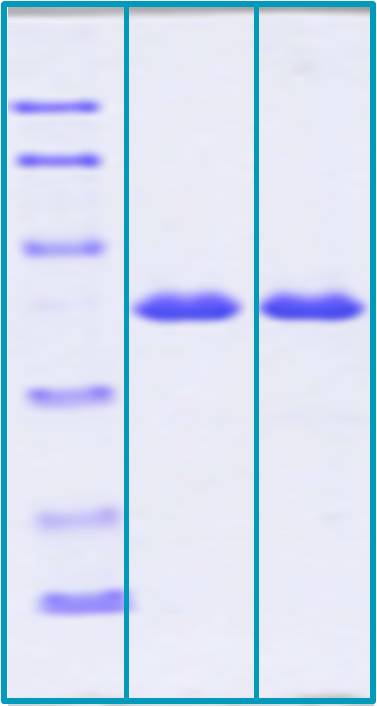Type
Recombinant protein
Description
Total 281 AA. MW: 29.6 kDa (calculated). UniProtKB acc.no. Q14896 (Met1-Phe271). N-terminal his-tag (10 extra AA). Protein identity confirmed by MS.
Amino Acid Sequence
MKHHHHHHASMPEPGKKPVSAFSKKPRSVEVAAGSPAVFEAETERAGVKVRWQRGGSDISASNKYGLATEGTRHTLTVREVGPADQGSYAVIAGSSKVKFDLKVIEAEKAEPMLAPAPAPAEATGAPGEAPAPAAELGESAPSPKGSSSAALNGPTPGAPDDPIGLFVMRPQDGEVTVGGSITFSARVAGASLLKPPVVKWFKGKWVDLSSKVGQHLQLHDSYDRASKVYLFELHITDAQPAFTGSYRCEVSTKDKFDCSNFNLTVHEAMGTGDLDLLSAF
Source
E. coli
Purity
˃ 90 % by SDS-PAGE
SDS-PAGE Gel
14 % SDS-PAGE separation of Human MYBPC3:
1. M.W. marker – 14, 21, 31, 45, 66, 97 kDa
2. Reduced and boiled sample, 2.5 μg/lane
3. Non-reduced and non-boiled sample, 2.5 μg/lane
Endotoxin
< 1.0 EU/µg
Formulation
Filtered (0.4 μm) and lyophilized in 20 mM Tris buffer, 50 mM NaCl, pH 7.5
Reconstitution
Add deionized water to prepare a working stock solution of approximately 0.5 mg/ml and let the lyophilized pellet dissolve completely.
Applications
Western blotting, ELISA
Shipping
At ambient temperature. Upon receipt, store the product at the temperature recommended below.
Storage/Expiration
Store the lyophilized protein at -80 °C. Lyophilized protein remains stable until the expiry date when stored at -80 °C. Aliquot reconstituted protein to avoid repeated freezing/thawing cycles and store at -80 °C for long term storage. Reconstituted protein can be stored at 4 °C for a week.
Quality Control Test
BCA to determine quantity of the protein.
SDS PAGE to determine purity of the protein.
Endotoxin level determination.
Note
This product is intended for research use only.
Research topic
Cardiovascular disease
Summary
Myosin binding protein-C (MyBP-C) is a modular thick filament protein belonging to the intracellular immunoglobulin (Ig) and fibronectin (Fn) superfamily. Three isoforms of MyBP-C are known in adult muscle: slow skeletal, fast skeletal and cardiac. These 3 isoforms share a similar structure consisting of several immunoglobulin and fibronectin modules and a myosin binding site in its C-terminal immunoglobulin model.
Cardiac MyBPC (cMyBP-C, MYBPC3) is a 140 kDa structural protein that is localized in the inner two-thirds of the A-band in the cardiac sarcomere. The cardiac isoform is present only in the heart. MyBPC3 stabilizes sarcomere structure and regulates actomyosin cross bridge formation. Structurally, cMyBP-C contains 12 domains. The three sites (Ser-273, Ser-282 and Ser-302) in cardiac-specific M-domain are differentially phosphorylated by the enzymes (protein kinase A - PKA, PKC, Ca2+-calmodulin-activated kinase II (CaMKII), PKD and the 90-kDa ribosomal s6 kinase). Phosphorylation of cMyBP-C regulates myocardial function and confers resistance to proteolysis, preserving cardiac function post-Myocardial infarction (post-MI).
Dephosphorylation at Ser-273 and Ser-282 facilitates cMyBP-C degradation and release of a 40 kDa N-terminal fragment (C0C1f). This C0C1f fragment is pathogenic within cardiac tissue and it is released into the circulation. C0C1f reduced cell viability, altered Ca2+ handling, and significantly decreased sarcomere length shortening and the velocities of contraction and relaxation by inhibiting actomyosin function. It was later established in vivo that the C0C1f fragment could cause cardiac dysfunction and heart failure.
Recent data implicate circulating C0C1f as having clinical utility and potentially serving as a novel biomarker for the early diagnosis of MI. Plasma levels of cMyBP-C are significantly elevated in MI samples. cMyBP-C levels increase from baseline at 3 hours after MI and peak at 6 hours. Moreover, cMyBP-C may be more useful than the gold standard biomarker cTnI, which is normally detected 6-12 hours after onset of MI. Importantly; it was shown that plasma cMyBP-C levels are significantly raised in humans with hypertrophic cardiomyopathy undergoing transcoronary ablation of septal hypertrophy.

